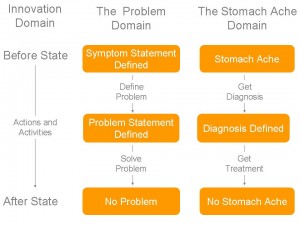Innovation, problems, and stomach aches
In the last post on innovation I said I’d provide data on number of hits for a post with innovation in the title. Well, apparently the word recession is more relevant than the word innovation as there were 50% more hits with recession. Next time I should use both recession and innovation in the title and see what happens.
In the last post on innovation I left off with the notion of an operational definition as a way to assign meaning to the word innovation. I ended with a question — can you put your hand over your mouth and point to innovation? In other words, what can we observe to bring innovation into the range of our experience? Starting with the state of things before innovation – what does it look like? And what about the state of things after innovation – what does that look like? And what does it look like to transition between the states?
Starting simply, the state before innovation is defined by a symptom statement, an ill-defined, un-actionable statement of something undesirable. It has not yet risen to the level of an actionable problem statement, but clearly there is a realization of an undesirable situation. Here are several examples of symptom statements.
I just finished my book last night. Those kerosene lamps are a real thing of beauty. But, I did have to fill it up with kerosene twice last night. And, they get dust all over the house. Hey, I heard that town hall just burned down because someone knocked the flame out one of those damn lamps.
Sure these horses pull the wagon all right, but they sure are high maintenance – they eat lot’s of hay, drop smelly stuff on the roads, require a special garage, and the mechanic has to tend to them daily. Also, they aren’t much fun at the drive in
I can’t believe this telegraph thing can send dots and dashes all the way across town. It’s great. But, you know, I really don’t like sharing that telegraph office with all the other folks, and there’s no call waiting. I’ve been thinking of opening one of those offices in my house.
Man, I really like these vacuum tubes. Just look at ‘em. They switch the electrons on and off with the best of them, but they sure do take their time doing it. And, you know what; this computer takes up a heck of a lot of space with all these tubes. Hey, why is so hot in here?
It takes a lot of hard work to transition to the next state. The symptom statement must be elevated to an actionable problem statement. We’ll save the description of that work for another time. But here are some examples of actionable problem statements.
This prototype light-creating device with the bulbous shape sure throws more light than those kerosene beauties, but that damn glowing filament doesn’t last more than 30 seconds. I’ve got to make that thing last longer.
Hey, I just drag raced a guy in brown, late model quarter horse. My new-fangled horseless carriage beat him off the line, but when I pulled on the reigns at the finish, the damn thing didn’t stop. I really need to create something that makes this thing stop when I want it to.
Watson, I can’t hear you worth a damn. If we can’t make that signal loud enough, we’re going back to Morse code.
Overheard at Bell Telephone Laboratories in 1947…..Hey, Shockley. What do you want Bardeen? Go wake up Brattain; we’ve got to get back to work and stop that damn transistor-thing from shorting out.
Remember, though there is an actionable problem statement in this state, we still have a problem. And it takes a lot of hard work to transition to the next state, where the problem is made to goes away. We’ll save a description of that work for another time. But, making the problem go away completes the transition to the end state of innovation (at least for now).
I have given you some examples of what the states of innovation look like through the example symptom and problem statements. However, I want to go further and draw a one-to-one parallel between the symptom, problem, state language and something that’s more in line with our experiences – having a stomach ache.
Below is a figure that shows three domains: innovation, problem, stomach ache. Let’s start with the state before innovation and the symptom statement. In the stomach ache domain the symptom statement is “My stomach hurts”. This is an ill-defined, un-actionable statement of something undesirable. You don’t know the problem; all you know is that your stomach hurts. Are you hungry? Do you have a digestion problem? A stomach virus? An ulser? Cancer? The situation is not actionable because there is no diagnosis.
The diagnosis work is next and it’s well known: make an appointment with your doctor; drive to the office; stick out your tongue and say ahhh. The doctor is trying to get a diagnosis (or define the problem). You are measured to gain insight – MRI, blood work, x-ray, and colonoscopy – and the data is analyzed. In the stomach ache domain, the next state is reached when a diagnosis is defined. This corresponds to a defined problem statement in the problem domain.
Though there is a defined diagnosis in this state, you are not yet feeling better. It’s time for treatment, and the treatment work is well known: get some rest; don’t eat spicy food; take the pills; surgery. Things are similar in the problem domain. Though there is a problem statement defined, your problem is not yet solved. It’s time to solve the problem.
In the state after treatment there is no stomach ache. In the state after innovation there is no problem.

 Mike Shipulski
Mike Shipulski